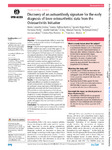Discovery of an autoantibody signature for the early diagnosis of knee osteoarthritis: data from the Osteoarthritis Initiative

View/
Use this link to cite
http://hdl.handle.net/2183/25147Collections
- Investigación (FCS) [1293]
Metadata
Show full item recordTitle
Discovery of an autoantibody signature for the early diagnosis of knee osteoarthritis: data from the Osteoarthritis InitiativeAuthor(s)
Date
2019-08-30Citation
Camacho-Encina M, Balboa-Barreiro V, Rego-Pérez I, Picchi F, VanDuin J, Qui J, et al. Discovery of an autoantibody signature for the early diagnosis of knee osteoarthritis: data from the Osteoarthritis Initiative. Ann Rheum Dis.2019;78(12): 1699-1705
Abstract
[Abstract] Objective To find autoantibodies (AAbs) in serum that could be useful to predict incidence of radiographic knee osteoarthritis (KOA).
Design A Nucleic-acid Programmable Protein Arrays (NAPPA) platform was used to screen AAbs against 2125 human proteins in sera at baseline from participants free of radiographic KOA belonging to the incidence and non-exposed subcohorts of the Osteoarthritis Initiative (OAI) who developed or not, radiographic KOA during a follow-up period of 96 months. NAPPA-ELISA were performed to analyse reactivity against methionine adenosyltransferase two beta (MAT2β) and verify the results in 327 participants from the same subcohorts. The association of MAT2β-AAb levels with KOA incidence was assessed by combining several robust biostatistics analysis (logistic regression, Receiver Operating Characteristic and Kaplan-Meier curves). The proposed prognostic model was replicated in samples from the progression subcohort of the OAI.
Results In the screening phase, six AAbs were found significantly different at baseline in samples from incident compared with non-incident participants. In the verification phase, high levels of MAT2β-AAb were significantly associated with the future incidence of KOA and with an earlier development of the disease. The incorporation of this AAb in a clinical model for the prognosis of incident radiographic KOA significantly improved the identification/classification of patients who will develop the disorder. The usefulness of the model to predict radiographic KOA was confirmed on a different OAI subcohort.
Conclusions The measurement of AAbs against MAT2β in serum might be highly useful to improve the prediction of OA development, and also to estimate the time to incidence.
Editor version
Rights
Atribución-NoComercial 3.0 España
ISSN
0003-4967






